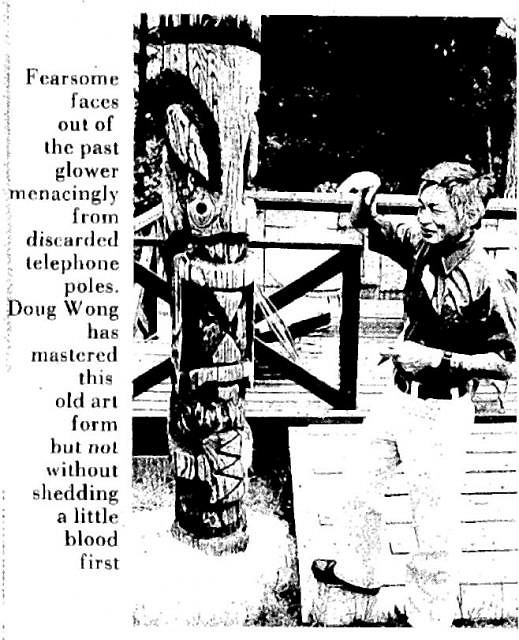P

Joined: Jul 07, 2005
Posts: 1564
|
P

And onto maybe a forgotten Tiki carver, Doug Wong. (Anyone know Doug?)
(From the Billings Gazette 21 November 1976)

CAMBRIDGE, Md, — The Polynesians carve tiki poles
to commemorate their gods but Ihe ancient art is spreading
In America as a backyard beautification idea or a special
project for Boy Scouts.
Doug Wong, hydroponic specialist at a foods plant in
Cambridge, has been creating tiki poles from old telephone
poles for tlie past five years.
"A TIKI POLE Is similar lo the American Indian totem
pole except the tiki pole is a representation of a single god
while the totem pole depicts an entire family or clan," said
Wong during a break In his bean sprout research.
To make a tiki pole, Wong recommends this equipment:
• A six lo eight-foot long section of telephone pole
• A sharp hatchet
• A hand-held propane torch
• Some chalk
• And this lesson in mind — slice the tree and not the
knee!
Wong's initial attempt at carving a tiki pole in 1971 resulted
in a four-Inch gash in his left knee when his hatchet
skimmed off the pole. After the cast was removed, Wong
reapproached the art with a healthy respect for safety.
"WHEN I MOVED from Seatlle to Cambridge to work
in the foods company's bean sprout program, I brought the
original pole with me," Wong says. "I figured it cost me
$1000 in hospital bills."
One of Ihe hardest parts of making a tiki pole is obtaining
the pole itself. Telephone companies generally give away
their old or damaged poles but there is often a waiting list.
The pole also should be at least one to two feet thick, according
to Wong.
Once the pole is secured, Ihe next step is choosing the
design. Wong recommends that those unfamiliar with the
Polynesian style check the library for examples of tiki pole
faces.
USING A HATCHET, thee face should be roughly outlined.
When tile pattern is on the pole, carefully chop down
to the desired depth while Irying to keep the cut wood as
smooth as possible.
Singe the pattern with the torch. Besides smoothing out
the wood, Ihls also creates a burnished effect that highlights
the natural grain of the wood. Finally, go over the pole with
a stiff whisk broom to remove the ash and burned wood
chips. At the suggestion of plant manager Al Schuchardt,
Wong recently instrucled members of the Boy Scout Troop
No. 298 in Cambridge on tiki pole caning. The scouts made
two poles lo use in their Bicentennial celebrations and also
hope to use them to raise money for community projects —
tiki poles have sold for as much as $850.
"IT CAN BE A DANGEROUS hobby if you push yourself
too fast," Wong said. "It will take about 50 hours of
working time lo make a pole but it's very enjoyable and satisfying."
Wong first saw tiki poles when he was in the South Pacific
us a merchant marine. But it wasn't until a telephone
crew removed an old pole from in front of his home that he
had the inspiration to carve one himself.
Creating a tiki pole can be fun, but just remember to
keep the hatchet in the wood and away from the legs.
|

